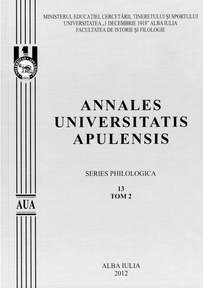LIMBAJUL PRIVAT WITTGENSTEINIAN ŞI COMUNICAREA
NONVERBALĂ
Limbajul privat wittgensteinian şi comunicarea nonverbală
Author(s): Cosmin-Constantin BăiaşSubject(s): Language and Literature Studies
Published by: Universitatea »1 Decembrie 1918« Alba Iulia
Keywords: Wittgenstein; philosophy of language; private language, intrapersonal communication; paralanguage; non-verbal communication; basic emotions
Summary/Abstract: Our paper proposes a nearness between the idea of private language in the late Wittgensteinian philosophy, more precisely the concept outlined about avowals or utterances, and the enlarged field of human communication. In paragraph § 243 of the paper Philosophical Investigations, the Austrian philosopher Ludwig Wittgenstein offers the following definition of private language: ”The words of this language are to refer to what can be known only to the speaker; to his immediate, private sensations. So another cannot understand the language.” From this short definition we may differentiate between the secret and the private character of the language; the non-communicable and non-intelligible character to others, to the third person; the privileged possession and knowledge of the first person, namely of the speaker or user of such an interior language. From a philosophical point of view the problem of the private Wittgensteinian language aims to question representations, intuitions or vague images, but still attractive and influential, that distort our way of thinking, as for example the Augustinian picture of language on one hand and the interior-exterior image of mind on the other hand, as bower of philosophical confusions. Beyond these aspects highlighted by other contemporary scholars too, our interpretation claims that Wittgenstein’s discussion about the possibility or impossibility of a private language outlines and makes us pay attention to other levels of communication besides the verbal one. First of all, similarly to the case of sensations, in the occurrence of basic emotions having a specific behaviour, namely universal facial expressions, we may also say that the non-verbal elements are the pattern and foundation on which the verbal communication is built. In the sense that, in the absence of behavioural manifestations, we could not learn and have concepts like “pain”, “sadness”, “anger”, “surprise”, “disgust”, “fear”, “contempt” or “joy”. And this is the basis of legitimating the field of non-verbal communication, which aims to identify and accurately assign experiences and thoughts to others. Surely, there is an essential indeterminacy of the interior, as our mental concepts do not relate the behaviour, the situation and the interior phenomenon in a rigid way.
Journal: Annales Universitatis Apulensis. Series Philologica
- Issue Year: 13/2012
- Issue No: 1
- Page Range: 433-446
- Page Count: 14
- Language: Romanian

